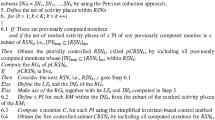Abstract
We consider liveness enforcing supervisory policies (LESPs) for a class of Petri net (PN) structures that model automated manufacturing systems that are prone to livelocks. This class is identified by the property that the existence of an LESP for an instance initialized with a marking implies the existence of an LESP when the same instance is initialized with a larger marking. If a minimally restrictive LESP prevents the occurrence of a transition at some marking for an instance, then every LESP for the instance should prevent the occurrence of the transition for the same marking. There is a unique minimally restrictive LESP for a PN that has an LESP. After reviewing the relevant theory, this paper describes the implementation details of a procedure for the automatic synthesis of the minimally restrictive LESP for any instance from the aforementioned class.









Similar content being viewed by others
Notes
Cf. p. 554, Murata (1989) for a formal definition.
lpsolve.sourceforge.net/5.1/lp_solveAPIreference.htm
References
Alpern, B., & Schneider, F. B. (1985). Defining liveness. Information Processing Letters, 21(4), 181–185.
Basile, F., Recalde, L., Chiacchio, P., & Silva, M. (2009). Closed-loop live marked graphs under generalized mutual exclusion constraint enforcement. Discrete Event Dynamic Systems, 19(1), 1–30.
Castillo, L., Fdez-Olivares, J., & González, A. (2000). A three-level knowledge-based system for the generation of live and safe petri nets for manufacturing systems. Journal of Intelligent Manufacturing, 11, 559–572.
Chandrasekaran, S., & Sreenivas, R. (2013). On the automatic generation of the minimally restrictive liveness enforcing supervisory policy for manufacturing- and service-systems modeled by a class of general free choice petri nets. In Proceedings of the IEEE International Conference on Networking, Sensing and Control (ICNSC-13), Paris, France, April 2013, session WeC01.3.
Ferrarini, L., Piroddi, L., & Allegri, S. (1999). A comparative performance analysis of deadlock avoidance control algorithms for FMS. Journal of Intelligent Manufacturing, 10, 569–585.
Ferrarini, L., Piroddi, L., & Allegri, S. (2004). Modeling and logic controller specification of flexible manufacturing systems using behavioral traces and petri net building blocks. Journal of Intelligent Manufacturing, 15, 351–371.
Ghaffari, A., Rezg, N., & Xie, X. (2003). Design of a live and maximally permissive Petri net controller using the theory of regions. IEEE transactions on robotics and Automation, 19(1), 137–142.
Giua, A. (1992). Petri nets as discrete event models for supervisory control. Ph.D. dissertation, ECSE Dept., Rensselaer Polytechnic Institute, Troy, NY.
Hu, H., & Li, Z. (2010). Synthesis of liveness enforcing supervisor for automated manufacturing systems using insufficiently marked siphons. Journal of Intelligent Manufacturing, 21(4), 555–567.
Hu, H., Zhou, M., & Li, Z. (2011). Supervisor optimization for deadlock resolution in automated manufacturing systems with petri nets. IEEE Transactions on Automation Science and Engineering, 8(4), 794–804.
Hu, H., & Liu, Y. (2014). Supervisor simplification for ams based on petri nets and inequality analysis. IEEE Transactions on Automation Science and Engineering, 11(1), 66–77.
Iordache, M. V., & Antsaklis, P. J. (2003). Design of \({\cal T}\)-liveness enforcing supervisors in Petri nets. IEEE Transactions on Automatic Control, 48(11), 1202–1218.
Li, L., Hadjicostis, C., & Sreenivas, R. (2004). Fault detection and identification in petri net controllers. In Proceedings of the 43rd IEEE conference on decision and control (CDC), Bahamas, December 2004 (pp. 5248–5253).
Li, S.-Y., An, A.-M., Wang, Y., Wang, G., Hou, C., & Cai, Y. (2013). Design of liveness-enforcing supervisors with simpler structures for deadlock-free operations in flexible manufacturing systems using necessary siphons. Journal of Intelligent Manufacturing, 24, 1157–1173.
Marchetti, O., & Munier-Kordon, A. (2009). A sufficient condition for the liveness of weighted event graphs. European Journal of Operations Research, 197, 532–540.
Moody, J., & Antsaklis, P. (1998). Supervisory control of discrete event systems using Petri nets. Dordrecht, MA: Kluwer Academic Publishers.
Murata, T. (1989). Petri nets: Properties, analysis and applications. Proceedings of the IEEE, 77(4), 541–580.
Ramadge, P., & Wonham, W. (1987). Modular feedback logic for discrete event systems. SIAM Journal of Control and Optimization, 25(5), 1202–1218.
Reveliotis, S. (2005). Real-time management of resource allocation systems: A discrete-event systems approach. New York: Springer.
Silberschatz, A., Galvin, P. B., & Gagne, G. (2009). Operating system concepts. London: Wiley.
Somnath, N., & Sreenivas, R. (2013). On deciding the existence of a liveness enforcing supervisory policy in a class of partially-controlled general free-choice Petri nets. IEEE Transactions on Automation Science and Engineering, 10(4), 1157–1160.
Sreenivas, R. (1997). On the existence of supervisory policies that enforce liveness in discrete-event dynamic systems modeled by controlled Petri nets. IEEE Transactions on Automatic Control, 42(7), 928–945.
Sreenivas, R. (2006). Some observations on supervisory policies that enforce liveness in partially controlled Free Choice Petri nets. Mathematics and Computers in Simulation, 70, 266–274.
Sreenivas, R. (2012). On the existence of supervisory policies that enforce liveness in partially controlled free-choice Petri nets. IEEE Transactions on Automatic Control, 57(2), 435–449.
Sreenivas, R. (2013). On a decidable class of partially controlled Petri nets with liveness enforcing supervisory policies. EEE Transactions on Systems, Man, and Cybernetics: Systems, 43(5), 1256–1261.
Valckenaers, P., & Van-Brussel, H. (2003). Deadlock avoidance in flexible flow shops with loops. Journal of Intelligent Manufacturing, 14, 137–144.
Valk, R., & Jantzen, M. (1985). The residue of vector sets with applications to decidability problems in Petri nets. Acta Informatica, 21, 643–674.
Acknowledgments
This work was supported in part by the National Science Foundation under Grant CNS-0834409.
Author information
Authors and Affiliations
Corresponding author
Rights and permissions
About this article
Cite this article
Chandrasekaran, S., Somnath, N. & Sreenivas, R.S. A software tool for the automatic synthesis of minimally restrictive liveness enforcing supervisory policies for a class of general Petri net models of manufacturing- and service-systems. J Intell Manuf 26, 945–958 (2015). https://doi.org/10.1007/s10845-014-0888-5
Received:
Accepted:
Published:
Issue Date:
DOI: https://doi.org/10.1007/s10845-014-0888-5




